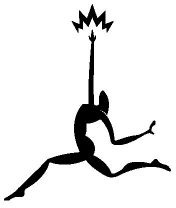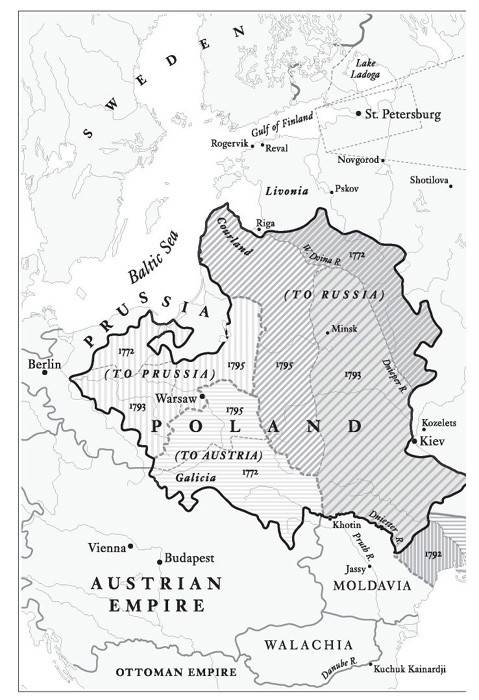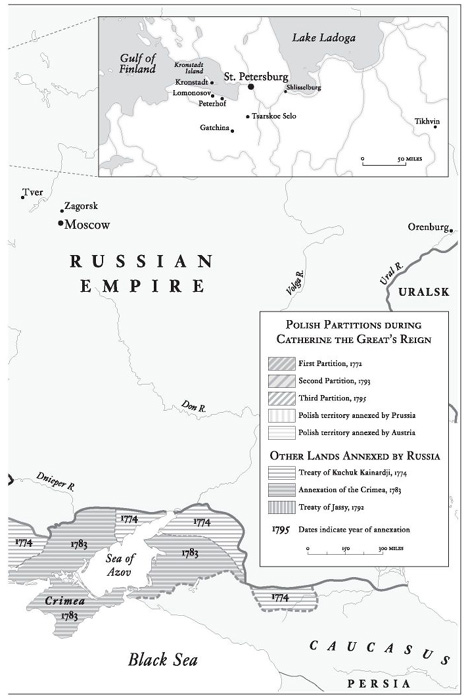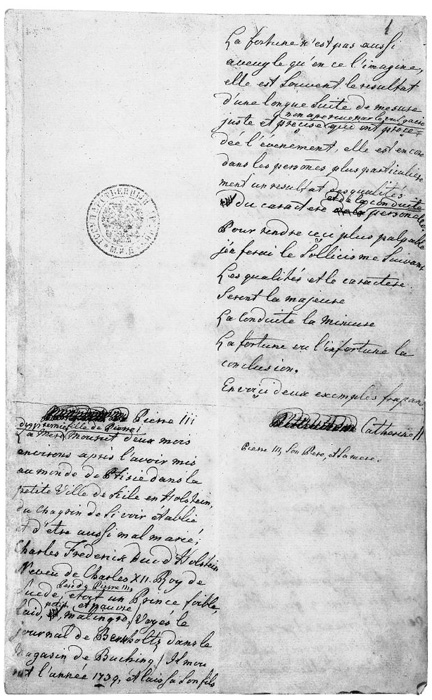The Memoirs of Catherine the Great (13 page)

Rulhière offers two versions of this story, one in which only Poniatowski is detained by the Grand Duke, and the other in which he locks up Catherine too.
Alexander,
Catherine the Great,
319.
Saint-Simon writes: “I call general history that which is indeed general, encompassing several nations or several centuries of church history, or one nation but many reigns, or one distant and far-reaching ecclesiastical act. I call particular history that of the time and country in which one lives. The latter, being less vast and occurring before the author’s eyes, must be much more extensive in details and circumstances, and have as its goal to place its reader in the midst of those actors of what is told, so that the reader believes less that he is reading a history or memoir, than to be himself in on the secret of everything that is represented to him, and a spectator of everything that is told.”
Mémoires,
xxix.
Faith Beasley argues that in seventeenth-century France, in the wake of the Fronde rebellion, which gave women a prominent political role, women especially turned to memoirs and fiction to argue for an alternative to official history that would include women.
Revising Memory: Women’s Fiction and Memoirs in Seventeenth-Century France
(New Brunswick, N.J.: Rutgers University Press, 1990).
Anisimov mentions this report without a citation. Evgenii Anisimov,
Elizaveta Petrovna
(Moscow: Molodaia gvardiia, 1999), 379.
Saturn, one of the Titans, ushered in a golden age in Italy, where he fled after he was displaced by his son Zeus. The final portrait in the Hermitage Museum does not have the two allegorical figures; the sketch is in the Russian Museum.
Aside from Caesar’s
Commentaries,
Marcus Aurelius’s
Meditations,
and Frederick II’s
Histoire,
there are Louis XIV’s
Mémoires pour l’instruction du Dauphin
for his son. Catherine too wrote instructions for her grandsons.
Janel Mueller and Leah S. Marcus, eds., Elizabeth I: Autograph Compositions and Foreign Language Originals (Chicago: University of Chicago Press, 2003); and Leah S. Marcus, Janel Mueller, and Mary Beth Rose, eds.,
Elizabeth I: Collected Works
(Chicago: University of Chicago Press, 2000).
“La Vie de la Reine Christine faite par Elle-même, dédiée à Dieu,” in
Mémoires concernant Christine, reine de Suède,
ed. Johann Arckenholtz, vol. 3 (Amsterdam and Leipzig: P. Mortier, 1759); 4 vols. (1751–60).
Russian memoirists wrote in French as well as Russian, calling their writings “notes” (zapiski). Tartakovskii identifies 700 documentary writings in Russian and other languages in the eighteenth century, with 250 memoirs and diaries by Russians and foreigners who had lived in Russia for a long time. The latter documents include travel memoirs, ethnographic reports, memoirs of the French Revolution, and family memoirs. A. G. Tartakovskii,
Russkaia memuaristika XVIII-pervoi poloviny XIX v.
(Moscow: Nauka, 1991), 22–23. The main source is P. A. Zaionchkovskii, Istoriia dorevoliutsionnoi
Rossii v dnevnikakh i vospominaniiakh,
5 vols. (Moscow, 1976).
Catherine titled her autobiographical letter of February 21, 1774, to Potemkin “A Sincere Confession.” Smith,
Love and Conquest,
9–11.
Catherine mentions both together in a letter to Grimm, May 13, 1791,
SIRIO,
23:538.
Rulhière,
A History, or Anecdotes of the Revolution in Russia,
6.




PART ONE
Fortune is not as blind as people imagine. It is often the result of a long series
of precise and well-chosen steps that precede events and are not perceived by
the common herd. In people it is also more specifically the result of qualities, of
character, and of personal conduct. To make this more concrete, I will make the
following syllogism of it:
1Qualities and character will be the major premise.
Conduct, the minor.
Fortune or misfortune, the conclusion.
Here are two striking examples.
Catherine II.
Peter III.
1728—43
Peter III’s childhood and education in Holstein;
heir to the Russian throne
The mother of Peter III, daughter of Peter I, died of consumption about two months after bringing him into the world in the little town of Kiel in Holstein, from the despair of being consigned to live there and from being so unhappily married.
2
Karl Friedrich, Duke of Holstein, nephew of Charles XII, King of Sweden, and father of Peter III, was a weak, ugly, short, sickly and poor prince (see Bergholz’s journal in Büsching’s
Maga
zin).
3
He died in the year 1739 and left his son, who was around eleven years old, under the guardianship of his cousin Adolf Friedrich, the Bishop of Lübeck and Duke of Holstein, since chosen King of Sweden as a result of the preliminary talks of the Treaty of Åbo on the recommendation of Empress Elizabeth.
4
Peter III’s education was directed by Brümmer, the Grand Marshal of the Court and a Swede by birth, and under him were Grand Chamberlain Bergholz, author of the aforementioned journal, and four chamberlains, two of whom—Adlerfelt, the author of a history of Charles XII, and Wachtmeister—were Swedish, and the other two, Wolff and Mardefeld, were from Holstein.
5
They raised the Prince for the throne of Sweden in a court that was too large for the country in which it was located and that was divided into several factions, which hated each other and vied to control the Prince’s mind, which each faction wanted to shape. As a result, these factions inspired in him the reciprocal hatred they felt against the individuals they opposed. The young prince politely detested Brümmer and his overbearing way and accused the Grand Marshal of excessive severity; he despised Bergholz, who was Brümmer’s friend and toady, and liked none of his attendants, because they hampered him.
From the age of ten, Peter III was partial to drink.
6
He had to make many public appearances and was never out of sight day or night. Those he liked best during his childhood and the first years of his stay in Russia were his two old valets: Kramer, a Livonian, and Romberg, a Swede. The latter was his favorite; he was a rather vulgar and rough man who had been a dragoon officer under Charles XII.
7
Brümmer and as a result Bergholz, who trusted blindly in Brümmer, were attached to Adolf Friedrich, Prince Bishop of Lübeck and Prince Guardian and Administrator; all the others were unhappy with this Prince and even more with his entourage.
Once Empress Elizabeth had ascended to the throne of Russia, she sent Chamberlain Korf to Holstein to summon her nephew, whom the Prince Administrator sent off immediately, accompanied by Grand Marshal Brümmer, Grand Chamberlain Bergholz, and Chamberlain Ducker, Brümmer’s nephew. The Empress’s joy was great when he arrived. She left shortly thereafter for her coronation in Moscow.
8
;
She was resolved to declare the Prince her heir. But first he had to profess the Greek Orthodox faith.
9
The enemies of Grand Marshal Brümmer, notably Grand Chancellor Count Bestuzhev and the late Count N. Panin, who had long been Russian minister in Sweden, claimed to have in hand convincing proof that as soon as Brümmer saw the Empress determined to declare her nephew heir apparent to the throne, he took as much care to spoil the mind and heart of his pupil as he had taken to make him worthy of the Swedish crown.
10
But I have always doubted this atrocious allegation and have believed that the education of Peter III was undermined by a clash of unfortunate circumstances. I will relate what I have seen and heard, and that in itself will clarify many things. I saw Peter III for the first time when he was eleven years old, in Eutin at the home of his guardian, the Prince Bishop of Lübeck. Some months after the death of Duke Karl Friedrich, Peter III’s father, the Prince Bishop had in 1739 assembled all of his family at his home in Eutin to have his ward brought there. My grandmother, mother of the Prince Bishop, and my mother, sister of this same Prince, had come there from Hamburg with me. I was ten years old at the time. Prince August and Princess Anna, brother and sister of the Prince Guardian and Administrator of Holstein, were also there.
It was then that I heard it said among this assembled family that the young duke was inclined to drink, that his attendants found it difficult to prevent him from getting drunk at meals, that he was restive and hot-headed, did not like his attendants and especially Brümmer, and that otherwise he showed vivacity, but had a delicate and sickly appearance. In truth, his face was pale in color and he seemed to be thin and of a delicate constitution. His attendants wanted to give this child the appearance of a mature man, and to this end they hampered and restrained him, which could only inculcate falseness in his conduct as well as his character.
Soon after this Holstein court arrived in Russia, it was followed by a Swedish embassy that requested the Empress allow her nephew to succeed to the Swedish throne. But Elizabeth, who had already declared her intentions in the preliminary talks of the Treaty of Åbo, mentioned above, replied to the Swedish Diet that she had already declared her nephew heir to the throne of Russia and that she adhered to the preliminary talks of the Treaty of Åbo, which made the Prince Administrator of Holstein heir apparent to the Swedish crown. (This Prince had had an older brother to whom Empress Elizabeth had been engaged after the death of Peter I. The marriage had not taken place, because the prince died of smallpox several weeks after the engagement. Empress Elizabeth retained tender feelings for his memory, and she gave tokens of her affection to the prince’s entire family.)
11
Peter III was thus declared Elizabeth’s heir and Grand Duke of Russia after he professed his faith according to the Greek Orthodox rite; Simeon Theodorsky, since named Archbishop of Pskov, was made his spiritual instructor.
12
The Prince had been baptized and raised in the Lutheran faith, the most rigid and least tolerant, and since his childhood he had always been resistant to all instruction. I heard it said by his attendants that at Kiel it had required great effort to make him go to church on Sundays and feast days, and to make him perform devotional acts, which were forced upon him, and that most of the time he acted irreligiously.
His Imperial Highness took it into his head to dispute every point with Simeon Theodorsky. Often his attendants were called in to cut short these bitter exchanges and to calm the Prince’s heated emotions. Finally, after much frustration, the Prince submitted to the wishes of the Empress, his aunt, although, whether from prejudice, habit, or a contradictory spirit, he often made it known that he would have preferred to leave for Sweden rather than stay in Russia.
He kept Brümmer, Bergholz, and his Holstein entourage around him until his marriage. Some other tutors were added to these as a formality: one was Monsieur Isaak Veselovsky for the Russian language, who came at first rarely and eventually not at all; the other, Professor Stählin, was supposed to teach him math and history, but in truth played with him and practically served as his buffoon. The most conscientious teacher was the ballet master Landé, who taught him to dance.
During this period, the Grand Duke spent all his time making two servants, who had been assigned for his personal service, perform military exercises in his private chambers. He gave them titles and ranks and demoted them according to his whim. These were truly the games of a child and of perpetual childishness. In general he was still very much a child, although he turned sixteen in 1744 when the Russian court was in Moscow.
